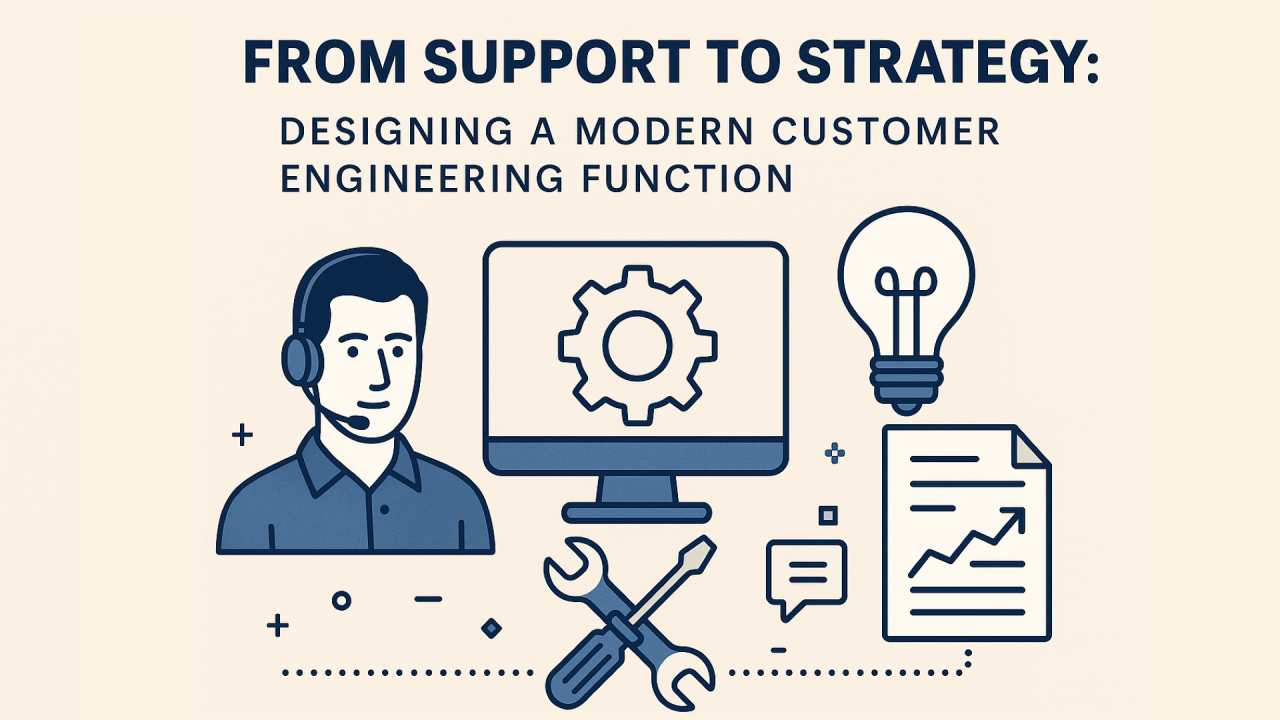Designing a Modern Customer Engineering Function

The complexity of modern software platforms—particularly in AI-native and developer-focused SaaS—has rendered traditional support engineering models insufficient. As products evolve faster and customers demand higher technical proficiency from vendors, a new function is emerging: Customer Engineering (CE).
Customer Engineering blends technical depth with customer empathy
Unlike traditional support, Customer Engineering is built around ownership, proactivity, and systems thinking. It blends technical depth with customer empathy and transforms the support function from a reactive service desk to a strategic capability that drives product feedback loops, accelerates adoption, and scales with automation.
This article outlines a strategic blueprint for organizations ready to modernize their support operations and establish a world-class Customer Engineering function.
1. Why Traditional Support Engineering Falls Short
Support Engineering was designed for a different era—one of monolithic apps, limited APIs, and well-defined error states. Today, support teams face:
- Rapid iteration cycles that outpace documentation
- Deeply technical customers expecting peer-level engagement
- Fragmented systems where root causes span product, infra, and third-party services
- Escalation fatigue as engineering is over-leveraged for repeatable issues
In this context, support engineers often become overwhelmed triage agents, unable to scale or influence the upstream systems creating the load.
2. What Is Customer Engineering?
Customer Engineering is a reimagined function that lives at the intersection of Support, Product, and Engineering.

A Customer Engineer (CE) is a technical, product-savvy problem solver who takes end-to-end ownership of customer friction, reduces dependence on Engineering, and scales outcomes through tooling, documentation, and AI.
3. Organizational Charter
A well-defined CE team has a mission that aligns with both customer success and internal efficiency. For example:
Mission: “To reduce customer friction and accelerate product adoption by owning, resolving, and eliminating technical blockers—without increasing load on Engineering or Product.”
Core Responsibilities
- Investigate and solve complex customer issues
- Identify patterns in product gaps or customer confusion
- Build or co-design internal tools, playbooks, and bots
- Create and maintain high-quality external documentation
- Collaborate with Product to influence roadmap based on feedback themes
- Partner with Engineering to reduce escalation volume
4. Building the Function: A 5-Stage Blueprint
Stage 1: Reposition the Function
Rename: “Customer Engineering” signals a mindset shift
Redefine the role internally: not just support, but product insight and enablement
Build credibility: embed CE into product onboarding, release cycles, and retrospectives
Stage 2: Recruit for Technical Curiosity & Ownership
Prioritize systems thinkers with software fluency
Screen for problem-solving approaches, not ticket throughput
Hire for versatility: ability to debug, write docs, speak with customers, and design process
Stage 3: Invest in Tooling & AI Automation
Internal tools for debugging and observability
External-facing bots and copilots to scale basic support
Ticket triage and routing automation
Feedback tagging and surfacing systems
Stage 4: Measure What Matters
Don’t measure CE like a traditional support team. Key metrics include:
- Escalation deflection rate
- Time-to-insight (diagnosis)
- Repetitive issue reduction
- Feedback volume per product area
- Self-service success rate (via docs, bots, etc.)
Stage 5: Operationalize Feedback Loops
Embed CE feedback in Product triage
Maintain dashboards of customer pain by feature/module
Co-own internal tools with Platform or Developer Experience teams
Participate in beta programs and early access rollouts
5. Common Pitfalls and How to Avoid Them

6. Case Study: A Hypothetical Scenario
A company like XYZ AI —supporting tens of thousands of monthly active developers building with LLMs—relies on CE to:
- Build copilot agents that assist human support
- Design observability tooling for better debugging
- Create structured feedback loops into the product development
- Drive down Engineering pings for predictable issues
- Design internal systems for playbook escalations
This is CE not just reacting but proactively shaping both customer experience and product evolution.
6. The Strategic Payoff
Organizations that invest in Customer Engineering experience:
- Lower churn through faster problem resolution
- Higher product velocity via clearer, more actionable feedback
- Happier engineers with fewer interruptions
- Better margins through scalable self-service and automation
- Customer trust rooted in competence and responsiveness
In other words, Customer Engineering doesn’t just fix issues—it helps design a better business.
Final Thoughts
Support no longer has to be reactive, siloed, or under-resourced. The emergence of Customer Engineering is a chance to build a technical, strategic, and scalable function that matches the complexity of modern SaaS.
Now is the time to elevate your support org from service desk to strategic driver.

